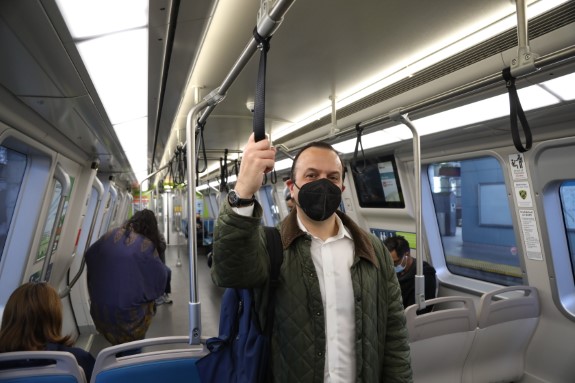Earth Day 2022: This is how much carbon you save by taking BART versus driving
Taking BART to the same place every day for one month emits less CO2 than driving the same route just once. That’s right, if you drive, your carbon footprint is about 30 times – 30 times! – larger than if you take BART.
On Earth Day, we celebrate the planet and advocate for greater environmental protections – a mission that feels all-the-more urgent as climate change continues to transform the earth and the lives of its inhabitants.
BART is one of the greenest options for Bay Area residents looking to move around the region. In 2020, BART achieved a 100% greenhouse gas-free (GHG-free) power supply with a combination of hydroelectric, solar, and wind energy. That means we’re sourcing energy from wind turbines, solar panels, and water. BART is also on-track to achieve 50% to 60% renewable energy in 2022, BART Energy Manager Paul Bostrom said.
To get a better sense of our carbon footprint by taking BART versus driving, the BART Sustainability Department created a calculation that describes emissions from the final station on each line to Embarcadero Station in San Francisco. To put things into perspective, 38 pounds of CO2 is about equal to burning two gallons of gasoline or charging about 2,100 smartphones.
Keep reading to see how much CO2 emissions you save by taking the train – and to hear from real-life patrons about why they chose BART.
Millbrae to Embarcadero Station
Average Auto CO2 emissions (lbs): 14.75
Average BART emissions (lbs): .46
Total length traveled (mi): 16.86
Cost on BART roundtrip: $10.10
Emmanuel recently started thinking differently about the environment and his carbon footprint. With a one-year-old at home, he said the state of the planet is often on his mind.
“It’s hard not to think about your carbon footprint, especially if you have a child,” he said, waiting for the Richmond-bound train to bring him to his office in San Francisco. “I hope the planet will still be here.”
When shown the difference in carbon emissions by taking BART to work versus driving, Emmanuel smiled.
“That makes me feel good,” he said. “At least I’m doing something small.”
Berryessa/North San Jose to Embarcadero Station
Average Auto CO2 emissions (lbs): 39.70
Average BART emissions (lbs): 1.23
Total length traveled (mi): 45.36
Cost on BART roundtrip: $16.30
Joseph Nurillo knows his way around a BART train. The college student commutes multiple times a week from his home in San Jose to the University of San Francisco – a nearly two-hour journey that begins with an hourlong BART ride and ends with a trip on Muni.
Nurillo said he drives a mid-size SUV when he’s not on BART, and knows “my carbon footprint is bad.” He said he takes BART to San Francisco to be a little greener in his day-to-day life, and to save money on gas.
Taking BART, he noted, is also faster than driving the highly trafficked highways into San Francisco.
“Being on BART makes me feel relieved. It’s way more stressful driving,” he said. “It’s tough commuting this far, but public transit makes it more manageable.”
Dublin/Pleasanton to Embarcadero Station
Average Auto CO2 emissions (lbs): 27.22
Average BART emissions (lbs): .84
Total length traveled (mi): 31.10
Cost on BART roundtrip: $13.20
Alexis Roma and Adrian Vera were traveling all the way to San Francisco from their homes in Modesto, Calif. The pair was dressed to the nines, looking forward to a K-Pop concert that evening in the city.
To get to San Francisco, they had driven to Dublin/Pleasanton Station, parked in the lot, and planned to take BART the rest of their journey.
“BART is very convenient, and with gas prices these days, it’s more affordable,” Vera said.
When they learned they’d be saving more than 30 pounds of CO2 by taking BART to San Francisco rather than driving, they patted themselves on the back.
“I’ve never really thought about [my carbon emissions], to be honest,” Roma said. “It’s good knowing I’m being more efficient.”
Richmond to Embarcadero Station
Average Auto CO2 emissions (lbs): 17.21
Average BART emissions (lbs): .53
Total length traveled (mi): 19.66
Cost on BART roundtrip: $10.10
Berlin was antsy as she rode BART from Richmond to Embarcadero Station on a recent weekday morning. The hairstylist was traveling to a job interview in San Francisco, and she had a 35-minute trip ahead of her.
“I don’t often go to the city or take BART,” she said. “But I think it’s nice to save the planet.”
She touted BART’s financial accessibility and noted that it’s much cheaper to take the train.
Will she BART to work each day if she gets the job?
“Definitely,” she said.
Antioch to Embarcadero Station
Average Auto CO2 emissions (lbs): 39.02
Average BART emissions (lbs): 1.21
Total length traveled (mi): 44.58
Cost on BART roundtrip: $15.80
It was obvious where Angela Hunter and Brinoea Sessions were headed when they stepped onto the BART platform at Antioch Station. Dressed in black and orange, the pair of Antioch-based teachers were taking BART to Opening Day at Oracle Park in San Francisco.
“It’s much cheaper taking BART than parking for the ballgame,” Hunter said. “And then when you take into consideration the price of gas…”
Both Hunter and Sessions said they predominantly take BART for economic reasons, but they view the environmental benefits as a plus.
Sessions said she hadn’t thought much about her carbon footprint – until she became a grandmother, that is.
“Now that I have grandkids, I think about sustainability,” she said. “It’s pretty scary.”
Methodology: To generate the data, BART’s Sustainability Department started by measuring the distance between stations using a geoprocessing tool. Next, to measure automobile emissions, the team calculated the average mile per gallon for an automobile based on a 20-year average of the Environmental Protection Agency’s real-world fuel economy estimate for all passenger vehicles. For BART’s emissions, the Sustainability team used BART’s total calendar year 2020 greenhouse gas emissions and divided that figure by the total number of passenger miles traveled in 2020. The emissions/passenger mile figure was then multiplied with the distances between stations.




